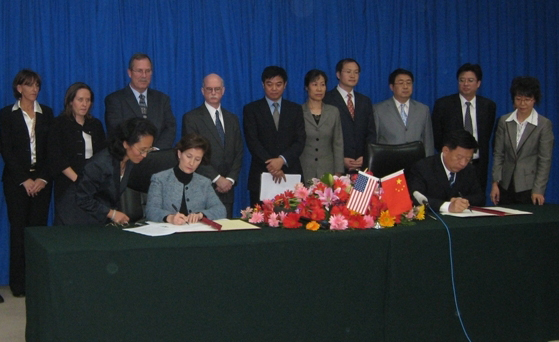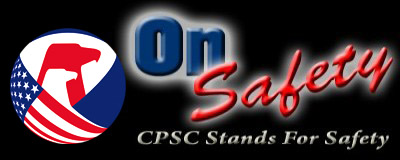OnSafety is the Official Blog Site of the U.S. Consumer Product Safety Commission. Here you'll find the latest safety information as well as important messages that will keep you and your family safe. We hope you'll visit often!
|
By CPSC Blogger on June 22, 2011

Sparklers burn at 2000 degrees F or even hotter.
That’s as hot as a blow torch.
It’s as hot as the charcoal fire in a grill.
2000 degrees is so hot it can melt copper.
Fireworks commonly known as bottle rockets, meanwhile, can fly through the air at 7 to 10 feet per second. Larger stick rockets are powerful projectiles with uncertain flight paths.
How fast are bottle and stick rockets? They fly erratically enough and are fast enough to hit someone by surprise and hurt them.
Fireworks like bottle rockets and small firecrackers may appear harmless because of their small size, but they sent 1,900 consumers to emergency rooms last year during the 30 days surrounding July 4th. In total, about 8,600 consumer emergency room visits in 2010 were from fireworks injuries.
Imagine spending your Fourth of July in the ER, most likely with a child with a burn or a severe cut. We’re guessing that’s not in your plans. You have much better ways to spend your time – swimming and barbecuing (safely, of course!) or watching your local, professional fireworks show.
If you do decide to buy legal fireworks, be sure to take the following safety steps:
- Never allow young children to play with or ignite fireworks.
- Avoid buying fireworks that come in brown paper packaging, as this can often be a sign that the fireworks were made for professional displays and could pose a danger to consumers.
- Always have an adult supervise fireworks activities. Parents often don’t realize that there are many injuries from sparklers to children under five.
- Never have any portion of your body directly over a fireworks device when lighting the fuse. Move away to a safe distance immediately after lighting.
- Never try to re-light or pick up fireworks that have not gone off or fully functioned.
- Never point or throw fireworks at another person.
- Keep a bucket of water or a garden hose handy in case of fire or other mishap.
- Light one item at a time then move away quickly.
- Never carry fireworks in a pocket or shoot them off in metal or glass containers.
- After fireworks have gone off and fully functioned, douse the spent device with plenty of water from a bucket or hose before discarding to prevent a trash fire.
- Make sure fireworks are legal in your area before buying or using them.
Know the risks. Prevent the tragedies. And have an injury-free Fourth!

This address for this post is: http://www.cpsc.gov/onsafety/2011/06/fireworks-hot-as-a-blow-torch/
By CPSC Blogger on March 11, 2010
 This “Rudolph the Red-Nosed Reindeer” bracelet manufactured by Buy-Rite Designs of Freehold, N.J., has high levels of cadmium and should be thrown away. Hey, Mom! Take those “Rudolph the Red-Nosed Reindeer” brand children’s Christmas and winter-themed bracelets away from your kids and throw them away.
That’s the latest safety alert from the Consumer Product Safety Commission. The charms on the bracelets tested with very high levels of cadmium.
The bracelets, which were sold at dollar stores nationwide, were flagged by the Associated Press in a January story about cadmium in children’s jewelry products.
These bracelets are the second round of children’s metal jewelry recalled by CPSC because of high levels of cadmium. The first was a recall of two “Princess and the Frog” necklaces.
CPSC reiterates that parents and caregivers should not allow young children to be given or to play with cheap metal jewelry, especially when they are unsupervised. Swallowing, sucking on or chewing a metal charm or necklace could result in exposure to lead, cadmium or other heavy metals, which are known to be toxic at certain levels of exposure.
Buy-Rite Designs of Freehold, N.J., The company that made the Rudolph bracelets, has gone out of business. Sorry, no refund.
 This Bumble Snowman bracelet manufactured by Buy-Rite Designs of Freehold, N.J., has high levels of cadmium and should be thrown away. This address for this post is: http://www.cpsc.gov/onsafety/2010/03/more-childrens-jewelry-found-to-have-high-levels-of-cadmium/
By CPSC Blogger on February 19, 2010
On Wednesday, CPSC Chairman Inez Tenenbaum addressed attendees of the International Consumer Product Health and Safety Organization conference at the Capital Hilton in Washington, D.C. Hear for yourself what she had to say about the agency’s priorities and commitment to consumers by watching the speech.
“When you look at the revitalization that has gone on at the CPSC, state regulators, and advocacy groups, 2010 is shaping up, in my opinion, to be the Year of the Consumer,” Tenenbaum said in her keynote speech.
Tenenbaum also spoke frankly to manufacturers, telling them to work quickly on new crib standards or the agency will act and telling them to take responsibility for defective products.
This address for this post is: http://www.cpsc.gov/onsafety/2010/02/2010-the-year-of-the-consumer/
By CPSC Blogger on October 26, 2009
 CPSC and its counterpart safety agency in China, the General Administration of Quality Supervision, Inspection, and Quarantine of the People’s Republic of China (AQSIQ), wrapped up the 3rd biennial Consumer Product Safety Summit today in Beijing. CPSC Chairman Inez Tenenbaum lead the U.S. delegation, which included the agency’s top technical experts and members of CPSC’s Compliance division. 20 U.S. stakeholders participated with the U.S. delegation. CPSC and its counterpart safety agency in China, the General Administration of Quality Supervision, Inspection, and Quarantine of the People’s Republic of China (AQSIQ), wrapped up the 3rd biennial Consumer Product Safety Summit today in Beijing. CPSC Chairman Inez Tenenbaum lead the U.S. delegation, which included the agency’s top technical experts and members of CPSC’s Compliance division. 20 U.S. stakeholders participated with the U.S. delegation.
The four-day summit was a platform for CPSC and AQSIQ to make very clear that times have changed. CPSC and AQSIQ put Chinese suppliers and U.S. importers on notice that it is a mistake to depend on good intentions and a few final inspections to ensure compliance with safety requirements. CPSC and AQSIQ will push companies to build safety into the product at every stage of the production and the distribution chain,” said Tenenbaum. “Suppliers and importers need to understand that this is now our expectation.” CPSC and AQSIQ will push companies to build safety into the product at every stage of the production and the distribution chain,” said Tenenbaum. “Suppliers and importers need to understand that this is now our expectation.”
Tenenbaum said CPSC will hold importers of products into the United States accountable if their products are hazardous or if they violate U.S. product safety requirements. AQSIQ will hold Chinese suppliers responsible for implementing best practices and building U.S. safety standards into their products before they reach U.S. ports.
“Our goal at CPSC is to protect families in and around their homes by ensuring the safety of the products they buy. That’s what this Summit has been about – protecting families,” said Tenenbaum.” The best way to protect families is to build safety standards into products during design and manufacturing.”
The next U.S. China Consumer Product Safety Summit will take place in the U.S. in 2011.
This address for this post is: http://www.cpsc.gov/onsafety/2009/10/day-4-u-s-china-consumer-product-safety-summit/
By CPSC Blogger on October 23, 2009
This address for this post is: http://www.cpsc.gov/onsafety/2009/10/chairmans-blog-from-china-day-3/
|
|











 CPSC and its counterpart safety agency in China, the General Administration of Quality Supervision, Inspection, and Quarantine of the People’s Republic of China (AQSIQ), wrapped up the 3rd biennial Consumer Product Safety Summit today in Beijing. CPSC Chairman Inez Tenenbaum lead the U.S. delegation, which included the agency’s top technical experts and members of CPSC’s Compliance division. 20 U.S. stakeholders participated with the U.S. delegation.
CPSC and its counterpart safety agency in China, the General Administration of Quality Supervision, Inspection, and Quarantine of the People’s Republic of China (AQSIQ), wrapped up the 3rd biennial Consumer Product Safety Summit today in Beijing. CPSC Chairman Inez Tenenbaum lead the U.S. delegation, which included the agency’s top technical experts and members of CPSC’s Compliance division. 20 U.S. stakeholders participated with the U.S. delegation. CPSC and AQSIQ will push companies to build safety into the product at every stage of the production and the distribution chain,” said Tenenbaum. “Suppliers and importers need to understand that this is now our expectation.”
CPSC and AQSIQ will push companies to build safety into the product at every stage of the production and the distribution chain,” said Tenenbaum. “Suppliers and importers need to understand that this is now our expectation.”